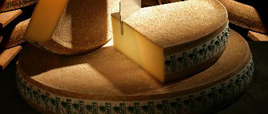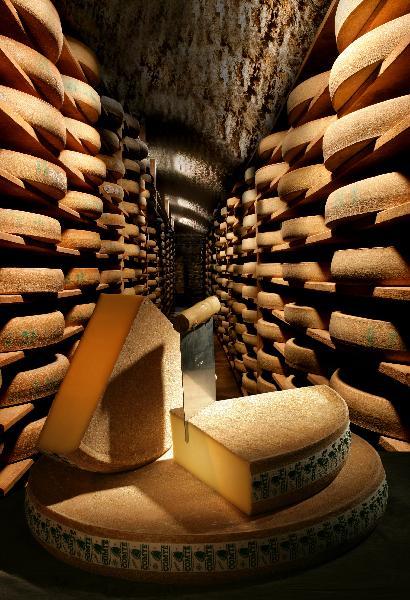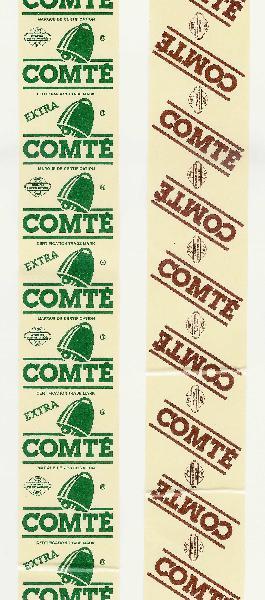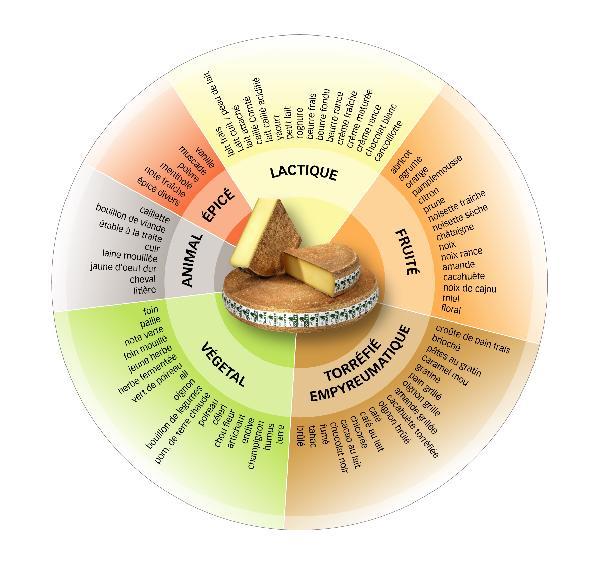Homage to Fromage
 Comte'
Comte'The manufacture of the cheese began as early as the 12th century, when shepherds would spend the summer months in their remote huts of the Jura Massif. The distance from towns of any size meant that any cheese they made would need to mature over a period of months. The milk was pooled between neighboring shepherds, and the huge cheeses would be stored until being carried to market at the end of the season.
Fresh from the farm, milk is poured into huge copper vats where it is gently warmed. Rennet, or another natural pressing agent is added causing the milk to coagulate. The curds are then cut into tiny white grains that are then stirred before being heated again for around 30 minutes. The contents are then placed into moulds and the whey is pressed out. After several hours the mould is opened and left to mature in cellars, first for a few weeks at the dairy, and then over several months elsewhere.
The Jura Massif is made up of medium-sized mountains that formed during the Jurassic period. Great plateaus at altitudes of between 500 and 1,500 metres are crowned with fir trees.

The rugged landscape is intersected by lush green valleys containing numerous rivers that are particularly well-stocked with fish. The seasons are markedly different and very clearly defined. Winters are rigorous and the thick blanket of snow creates a magical, majestic atmosphere. It is a paradise for cross-country skiers. After the thaw, the meadows are filled with a dazzling display of spring flowers. Once again the hillsides are filled with the sound of the Montbéliardes’ clanging bells as they return to the tender grass under the last clumps of snow. In the heart of the summer, the gentle sound of the lazily flowing rivers encourages ramblers and holiday makers to enjoy a post picnic snooze. Here, the concept of “green tourism” is given full expression. In the autumn, the foliage puts on a last fiery display before the cold weather sets in. The diversity of the Jura forests composes a spectacular symphony of reds and golds. This often very mild season is perfect for solitary walks along the paths carpeted with leaves.
The production of Comté milk
 While modern techniques have been embraced where they can facilitate procedures and increase quality, the production of Comté remains based on traditional methods. Each stage is subject to strict rules that are set down in the AOC specifications. First of all, Comté milk is produced on more than 3,000 family farms practicing non-intensive agriculture, i.e. agriculture that, rather than aiming for the highest possible yields, focuses on quality, and takes into account soil characteristics.
While modern techniques have been embraced where they can facilitate procedures and increase quality, the production of Comté remains based on traditional methods. Each stage is subject to strict rules that are set down in the AOC specifications. First of all, Comté milk is produced on more than 3,000 family farms practicing non-intensive agriculture, i.e. agriculture that, rather than aiming for the highest possible yields, focuses on quality, and takes into account soil characteristics.The flora in the Jura Massif is very diverse and, depending on where they are located, cows may graze on different plants. This is reflected in the milk and, ultimately, in the varying flavors of the cheese. For there to be enough forage to feed a herd, farmers must provide at least one hectare of grazing area for each dairy cow. The cows are milked mornings and evenings. The milk has to be brought to the cheese dairy every day. In order to express the diversity of the soil and types of grazing as best as possible, the foraging zone for each cheese dairy is limited to an area with a diameter of twenty-five kilometres.
The cheese-making process must start within twenty-four hours of the milk being collected, and so Comté is made every day. Local producers bring their milk to the cheese dairy where it is made into Comté. Often located in the center of the village, the cheese dairies (there are 170 spread over the Jura Massif) receive milk everyday from the surrounding farms. The method for making Comté has not changed for centuries. Its aim is to produce a cheese that keeps well, and so is of a substantial size and has a low water content, while at the same time preserving the natural flora in the raw milk, which gives the cheese its rich flavour. The method involves several stages:
 When it comes to acquiring flavor, Comté cannot be hurried. In the silence and shadowy darkness of the cellars Comté undergoes a second transformation and is carefully looked after so as to encourage the natural development of flavors as the months pass by. In French there is a special word, affiner, which means to complete the maturing process of cheese.
When it comes to acquiring flavor, Comté cannot be hurried. In the silence and shadowy darkness of the cellars Comté undergoes a second transformation and is carefully looked after so as to encourage the natural development of flavors as the months pass by. In French there is a special word, affiner, which means to complete the maturing process of cheese.The rounds of cheese sit on spruce boards and are regularly salted, rubbed with a brine solution called morge, and turned over. As a result of these procedures, the rind develops, the initially grainy and elastic texture of the cheese becomes smooth and supple. The whey flavor that dominates at unmoulding, gradually becomes richer and more refined. During this period in the cellar (from a minimum of four months to eighteen or even twenty-four months), each Comté acquires a “personality”, developing a unique texture, color and range of flavors.
Time spent in a hot cellar encourages the formation of eyes (holes) and certain types of flavor. In cold cellars, the cheese evolves more slowly and different flavors develop.
The Massif du Jura has around twenty maisons d’affinage (“maturing houses”); each one offering a maturing process that is a function of its location, its cellar conditions and techniques, and which is suited to the cheese that has been delivered.
Inspection: green band or brown band?
 When it leaves the cellar, a green or brown “marking band” is given to each Comté as an indication of its quality. This is attached by the affineur who grades each wheel of cheese on the basis of various criteria, amongst which flavor is the most important.
Cheeses awarded a grade of 15/20 or more receive a green band, entitling them to be called “Comté extra”, while cheeses that are graded from 12 to 15 receive a brown band and are simply called “Comté”. Cheeses with a grade of less than 12 may not be called Comté and are generally used to make cheese spreads.
When it leaves the cellar, a green or brown “marking band” is given to each Comté as an indication of its quality. This is attached by the affineur who grades each wheel of cheese on the basis of various criteria, amongst which flavor is the most important.
Cheeses awarded a grade of 15/20 or more receive a green band, entitling them to be called “Comté extra”, while cheeses that are graded from 12 to 15 receive a brown band and are simply called “Comté”. Cheeses with a grade of less than 12 may not be called Comté and are generally used to make cheese spreads.The grading of Comtés is based not only on flavor but also the wheels’ physical appearance. So a brown band could be the result of a minor defect in appearance in an otherwise excellent cheese. A “green” or “brown” band is the guarantee of an authentic Comté with a minimum age of four months. The different colors are not an indication of different ages or of different types of flavor.
A professional panel meets regularly to examine samples taken from cheeses leaving the maturing cellars and to check that the bands have been correctly allocated. Each cheese is awarded a score out of 20 by inspectors, according to 'overall appearance' (1 mark), 'quality of rind' (1.5), 'internal appearance' (3.5), 'texture' (5), and taste (9). Those scoring 15 or above are given green labels (with the characteristic image of a bell), with 12-15 being given red labels. Any cheese scoring under 3 marks for taste, or under 12 overall is prohibited from being named Comté and is instead sold as Gruyère.
 The result: an infinite diversity of flavors...
The result: an infinite diversity of flavors...La roue des arômes du ComtéThe result of the various rules and techniques involved in its production is that Comté is the opposite of a cheese with a standardized flavor and is in fact characterized by a great diversity of flavor. The main sources of these variations are:
Geographical origin
This is expressed through the 170 cheese dairies each of which reflect the local soil, microclimate and flora. As part of the Programme Terroir, a study of the local flora enabled the counting of more than 400 plant varieties — with an average of 130 varieties for each cheese dairy.
Time of year
The cows’ diet changes with the seasons. In winter, they come indoors where they eat hay and then in the spring they return to the pastures to graze on grass and flowers. In the same field, the varieties of plants growing can change from one month to the next, and thus the cows’ diet also changes. The diversity of this diet has an effect on the color and the taste of the cheese all through the year.
Expertise
Through their experience and expertise, cheese makers and affineurs also influence the transformation of the milk and the development of the cheese. Cheese makers adapt their techniques to the milk that they receive and the affineur chooses the cellars and directs the procedures that take place during the maturing process. .
Length of the maturing period
The taste and texture of a cheese continue to evolve all during the time that it spends in the maturing cellars.
Beautifully fruity, sweet, and lightly tangy, Comte is famous for its notes of toasted hazelnuts, and its woodsy finish is reminiscent of brown bread. It makes a wonderful fondue, or served as a table cheese for breakfast (or any time) with fresh fruit and a rustic, crusty loaf of bread.


